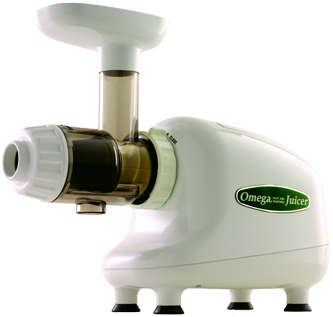Update: 21 December 2024
Organic Carrot Juice
Author: Julie Casper, C. Ac.

Carrot juice is a ‘nature-balanced’ source of many nutrients, including vitamin A (beta carotene), B, C, E, and other essential minerals.
Carrot juice provides nutrients and minerals needed by our cells in bioavailable form. Vitamin A is necessary for tissue growth, especially in bones. Vitamin A is also very important in maintaining good vision. Vitamin C has a wide variety of uses throughout our entire body, such as collagen production of the mucous membranes, skin, bones, and teeth. Vitamin C is also a crucial antioxidant. In addition, carrots grown nutrient-rich soil contain a multitude of trace minerals essential to health. Organic carrot juice adds extra minerals to the diet. It is an excellent source of potassium. Potassium is important in helping to maintain a healthy electrolyte balance and fluid level in the cells of your body. Potassium also is necessary in muscle movement (contraction), as well as neurotransmission. Potassium deficiencies are associated with hypokalemia, acne, muscle spasms, dry skin, and elevated cholesterol levels.
Carrots contain a bio-available form of calcium and magnesium in a healthy balance. Bones and teeth are dependent on calcium and magnesium for growth and formation (especially the skeletal structure and development of children). Magnesium works synergistically with vitamin A. Like potassium, calcium is important for neurotransmission, and muscle movement and contraction. Magnesium is needed for muscle relaxation. A healthy calcium/magnesium ratio is needed for proper function of all your muscles, including your heart, blood vessels and digestive tract.
Heaven is the place where the donkey at last catches up with the carrot. Anonymous
Carrot's Health-Promoting Properties
The carrot is an important root vegetable that is rich in bioactive compounds including carotenoids and dietary fibers, with appreciable levels of several other functional components having significant health-promoting properties. The carrot's popularity is increasing, in part because it is an important source of natural antioxidants which exhibit anticancer activity. Biochemically, the carrot is a rich source of β-carotene, fiber and many essential micronutrients and functional ingredients. Because of the presence of high concentrations of carotenoids, especially the β-carotene found in carrot roots, carrots not only inhibit cancers, they are free radical scavengers, anti-mutagenic, and increase the immune response.
- Chemical composition
- Carrots are a good source of carbohydrates and minerals, including calcium [Ca], phosphorus [P], iron [Fe] and magnesium [Mg]. An analysis of the chemical constituents of carrot revealed; moisture (86%), protein (0.9%), fat (0.2%), carbohydrate (10.6%), crude fiber (1.2%), total ash (1.1%), Ca (80 mg/100 g), Fe (2.2 mg/100 g) and P (53 mg/100 g). However, due to wide range of growing and soil conditions the values reported for most of these parameters will vary. The edible portion of carrots contains about 10% carbohydrates. Free sugars are sucrose, glucose, xylose and fructose (Kalra et al. 1987). The taste of carrots is mainly due to the presence of glutamic acid and the buffering action of free amino acids. Caffeic acid is the predominant phenolic acid in carrots. Thiamin, riboflavin, niacin, folic acid and vitamin C are present in appreciable amounts in carrot roots (Howard et al. 1962; Bose and Som 1986). .
- Carotenoids
-
Carotenoids are organic pigments that are found in the chloroplasts and chromoplasts of plants. Carotenoids are present intracellularly and their actions are involved in the regulation of gene expression, or effect cell functions like inhibition of monocyte adhesion and platelet activation (Rock 1997). These biological effects are independent of the pro-vitamin A activity and have been attributed to the antioxidant property of carotenoids. In general, carotenoids in foods are classified into carotenes and xanthophylls, which give attractive red or yellow color and contribute to food quality.
Carotenoids are important micronutrients for human health (Castermiller and West 1998). The total carotenoids content in the edible portion of carrot roots range from 6,000 to 54,800 μg/100 g (Simon and Wolff 1987). The main physiological function of carotenoids is as precursor of vitamin A (Nocolle et al. 2003). In the past decade carotenoids such as β-carotene have attracted considerable attention because of their possible protective effect against some types of cancers (Bast et al. 1996; Santo et al. 1996; Van 1996). In human system, the physiological activity of α- and β-carotene has been 50 and 100% of the pro-vitamin A activity, respectively (Panalaks and Murray 1970; Simpson 1983). Carotenoids have been linked with the enhancement of immune system and decreased risk of degenerative diseases such as cancer, cardiovascular disease, age related macular degeneration and cataract formation (Mathews-Roth 1985; Bendich and Olson 1989; Bendich 1990; Krinsky 1990; Byers and Perry 1992; Bendich 1994; Krinsky 1994; Faulks and Southon 2001). Carotenoids have been identified as a potential inhibitor of Alzheimer's disease (Zaman et al. 1992).
Health Promoting Functions Attributed to Carotenoids
The presence of a high concentration of antioxidant carotenoids, especially β-carotene, may account for the biological and medicinal properties of carrots. Carrots have been reported to have diuretic, N-balancing properties and are effective in the elimination of uric acid (Anon 1952). Numerous animal experiments and epidemiological studies have indicated that carotenoids inhibit carcinogenesis in mice and rats and may have anticarcinogenic effects in humans. In biological systems, β-carotene functions as a free radical-trapping agent and single oxygen quencher and have antimutagenic, chemopreventive, photoprotective and immunoenhancing properties (Deshpande et al. 1995). Carrot intake also may enhance the immune system, protect against stroke, high blood pressure, osteoporosis, cataracts arthritis, heart diseases, bronchial asthma and urinary tract infection (Beom et al. 1998; Sun et al. 2001; Seo and Yu 2003). Carotenoids also act as free-radical scavengers and are very important for health (Bast et al. 1998; Bramley 2000). D'Odorico et al. (2000). Carotenoids have shown that the presence of α- and β-carotene in blood has a protective effect against atherosclerosis. High carotenoid diets are associated with a reduced risk of heart disease, Nocolle et al. (2003).
- Carotenoids inhibit cancer.
- Carotenoids prevent cardiovascular disease.
- Carotenoids decreased the risk of cataract formation.
- Carotenoids prevent muscular degeneration.
- Carotenoids promote vitamin-A activity.
- Carotenoids enhance the immune function.
- Phytonutrients
- Plant components, primarily secondary metabolites that have health promoting properties, are called phytonutrients. The importance of antioxidant constituents in the maintenance of health and protection from coronary heart disease and cancer is well researched. In vitro studies indicated phytonutrients such as carotenoids and phenolics may play a significant role, in addition to vitamins in protecting biological systems from the effects of oxidative stress (Kalt 2005). The carrot is a significant source of phytonutrients including phenolics (Babic et al. 1993), polyacetylenes (Hansen et al. 2003; Kidmose et al. 2004) and carotenoids (Block 1994). Carrots are rich in β-carotene, ascorbic acid and tocopherol and are classified as vitaminized food (Hashimoto and Nagayama 2004). Due to the appreciable level of a variety of different compounds present, carrots are considered a functional food with significant health promoting properties (Hager and Howard 2006).
- Phenolics
- Phenolics, or polyphenols, have received considerable attention because of their physiological functions, including antioxidant, antimutagenic and antitumor activities. They have been reported to be a potential contender to combat free radicals, which are harmful to our body and foods systems (Nagai et al. 2003). Although, phenolic compounds do not have any known nutritional function, they may be important to human health because of their antioxidant potency (Hollman et al. 1996). Phenolics are ubiquitous plant components that are primarily derived from phenylalanine via the phenylpropanoid metabolism (Dixon and Paiva 1995). The phenolic contents in different tissues decreased in the following order peel > phloem > xylem. Although, carrot peel accounted for only 11% of the amount of the carrot fresh weight, it could provide 54.1% of the amount of total phenolics, while the phloem tissue provides 39.5% and the xylem tissue provides only 6.4%.
- Dietary fibers
- Dietary fibers are indigestible complex carbohydrates found in the structural components of plants. They cannot be absorbed by the body, and therefore have no calorific value. However, the health benefits of eating a fiber-rich diet include; the prevention of constipation, regulation of blood sugar, protection against heart diseases, and the prevention of certain forms of cancers. Carrots are high in dietary fibers and these fibers play an important role in human health (Anderson et al. 1994). Diets rich in dietary fibers are associated with the prevention, reduction, and treatment of diseases such as diverticular and coronary heart diseases (Anderson et al. 1994; Gorinstein et al. 2001; Villanueva-Suarez et al. 2003).
Excerpt from: Chemical composition, functional properties and processing of carrot
Recommended Daily Amount
Adults can drink about 6-10 ounces of carrot juice daily. Reduce the amount for children. Carrots can be quite high in sugar, especially very sweet ones. They contain about 10% carbohydrates (sucrose, glucose, xylose and fructose). Safe clean produce is also important. You can soak carrots in a solution of 3% food grade hydrogen peroxide (H2O2) to neutralize pathogens, kill parasites and keep them fresh longer.
NOTE: Carrot juice should taste very sweet and delicious. The reason for bad flavor may be that the carrots were grown in nutrient depleted soils, or the quality of water used for irrigation was bad. Even toxic over-drift from neighboring non-organic fields can be a factor. If your juice tastes "off" we recommend you find a better source for carrots.
Recipe · Carrot Juice Cocktail

Modified from Nourishing Traditions by Sally Fallon (pg. 609)
Add enough carrots to yield 6-10 oz. Whole milk and cream are high in vitamin D and provide a nice balance to the sugar (a nice flavor too), added to carrot juice it helps the body convert carotene more efficiently into vitamin A (retinol). This remedy is used successfully in European clinics for treatment of cancer, psoriasis and other diseases.
Ingredients
- Organic carrots, approx. 1 lb depending on quality and freshness
Optional Ingredients
- 2 tablespoons full-fat organic cream or milk (more or less is up to you). Non-dairy organic coconut milk is delicous too. And, the fat helps mitigate high-sugar dose.
- A dash of Organic Pure Vanilla Extract.
- Very small amount of Celtic sea salt enhances the perception of sweetness (because the sodium half of the NaCl molecule suppresses bitterness).
- Favorite greens, or 1 tablespoon wheat grass powder.
- 1/2 raw beet, red or golden. Beets are an excellent digestive aid and provide 11% DV of potassium (U.S. FDA ‘Daily Value’).
- 1-3 teaspoons of organic cold-pressed hemp seed oil.
Directions
Process carrots in a low RPM (masticating) juicer to maintain the highest quality nutrition and reduce oxidation. Stir in cream (or raw milk or yogurt). Sip slowly for maximum enjoyment.

Low-speed Masticating Juicer
Recommended Juicing Equipment
A high-quality horizontal single gear masticating juice extractor is best because they operate at low speed (80 RPM) producing minimal heat and oxidation, minimizing damage to health promoting enzymes. Also excellent for grinding coffee beans for use in enema therapy and superior drinking coffee (eliminates hi-speed damage and metal contamination from grinding blades).
How to clean a juicer (homemade Oxy-Cleaner)
Mineral and stain buildup on juicer parts and on the screen can reduce yield and even damage the juicer. But cleaning the parts can be quite difficult. Here is a recipe for an easy-to-use, non-toxic, homemade oxygen cleaner. Soak the parts in a container until the residue brushes off easily (soak up to an hour or over night is fine).
Homemade Oxy-Cleaner Recipe
CAUTION: Although it is non-toxic, this solution can damage wood finishes.
- 1 part - Washing soda (it's made by Arm & Hammer Co. and looks like their "baking soda" box)
- 1 part - Hydrogen peroxide (cheap grocery store stuff is fine for cleaning purposes)
- 2 parts - Very hot water (so the washing soda dissolves)
Resources
- Why does salt make (almost) everything taste better?
- Research: Chemical composition, functional properties and processing of carrot
- The Wonders of Carrot Juice The Carrot Museum U.K.